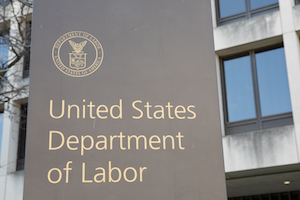Employer plan sponsors and fiduciaries that are subject to the prohibited transaction rules as set forth in ERISA and the Internal Revenue Code (IRC) will want to take note of new procedures for granting administrative transaction exemptions. 
The Department of Labor’s Employee Benefits Security Administration (EBSA) on Jan. 23 announced that it is amending its “Procedures Governing the Filing and Processing of Prohibited Transaction Exemption Applications” that was published in 2011. The notice finalizes the Exemption Procedure Regulation that the department proposed in March 2022.
As discussed throughout the 154-page document, the Exemption Procedure Regulation sets forth the process by which the department makes exemption determinations with respect to applications for administrative relief from the prohibited transaction provisions of ERISA and the IRC.
“The amended exemption procedure will create more clarity, certainty and transparency around the exemption application process,” Lisa Gomez, Assistant Secretary for Employee Benefits Security, said in a statement. “Ensuring consistent and transparent procedures for the department to process exemption requests will benefit applicants and the public at large.”
As background, both ERISA and the IRC contain various statutory exemptions from the prohibited transaction rules to prevent the disruption of various business practices involving employee benefit plans, parties in interest, and fiduciaries. Among other things, the statutory exemptions afford relief for transactions such as loans to participants and stock ownership plans, the provision of services necessary for the operation of a plan, certain investment advice transactions, and the investment of plan assets.
In addition to the statutory exemptions, ERISA section 408(a) authorizes the Labor Secretary to grant administrative exemptions from the restrictions of ERISA sections 406 and 407(a) in instances where the Secretary makes a finding on the record that relief is (1) administratively feasible, (2) in the interests of the plan and its participants and beneficiaries, and (3) protective of the rights of participants and beneficiaries of such plan.
DOL notes that, while the final amendment made several changes to the proposed rule in response to comments, it retains the current section-by-section topical structure and most of the operative language of the current Exemption Procedure Regulation.
Final Amendment
To that end, the final amendment revises the current regulation to promote the department’s goal of “promptly and efficiently making exemption determinations pursuant to a transparent process” by:
- Clarifying the types of information and documentation required for a complete application.
- Revising the definitions of a qualified independent fiduciary and qualified independent appraiser to ensure their independence.
- Clarifying the content of specific reports and documents applicants must submit to ensure that the department receives sufficient information to make the requisite findings under ERISA Section 408(a) to issue an exemption.
- Updating various timing requirements to ensure clarity in the application review process.
- Specifying items that are included in the administrative record for an application and when the administrative record is available for public inspection.
- Expanding opportunities for applicants to submit information to the department electronically.
Revenue Thresholds and Independence
As with the definition of a qualified independent appraiser, the department proposed to revise the revenue threshold used to determine independence in the proposed rule, but decided against doing so, and has largely reverted to the original revenue thresholds set forth in the existing regulation. However, as with the definition of a qualified independent appraiser, the DOL has revised the language in the final amendment to clarify the underlying intent of the existing language.
Specifically, the final amendment states that the DOL generally “will not conclude that a fiduciary’s independence is compromised solely based on the revenues it receives from parties in interest (and their affiliates) that are participating in the exemption transaction if the fiduciary neither receives nor is projected to receive more than 2% of its revenues within the current Federal income tax year from the parties in interest (and their affiliates),” the DOL explains in the preamble.
The guidance adds that, “Although larger percentages merit more stringent scrutiny, a fiduciary may be considered independent based upon other facts and circumstances provided that the fiduciary neither receives nor is projected to receive more than 5% of its revenues within the current Federal income tax year from parties in interest (and their affiliates) participating in the exemption transaction.”
The DOL explains that the revised language addresses the commenters’ concerns that the proposed changes could have negatively impacted the independent fiduciary marketplace while giving proper weight to the participant-protective independence of the fiduciary, initially raised as a concern in the proposed rule.
More Info Up Front
The DOL also notes that it is requiring applicants to include more information upfront as part of their exemption applications, which the department believes “will lead to an efficient determination process.” Specifically, the department is requiring applicants to include information relevant to the cost and benefits of the transaction, alternative transactions to the exemption transaction that were considered, the benefits derived by the parties involved, and explicit descriptions of all known conflicts involved with the transaction.
In observing that the baseline regulation already requires applicants to submit most of this information, DOL notes that it amended the Exemption Procedure Regulation to align more closely with the information the department frequently requests from applicants to determine its statutorily mandated findings, and to require such information to be submitted sooner in the process rather than after the department requests it.
“Having the information provided with the application clarifies expectations about required information. Also, time is saved as back-and-forth discussions about required information are reduced,” the DOL explains in the preamble.
The amendments are effective 75 days after publication in the Federal Register.
The Final Exemption Procedure Regulation Notice is here.
- Log in to post comments
